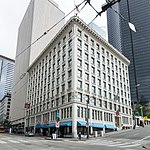3rd & Cherry
Proposed skyscrapers in the United StatesResidential skyscrapers in Seattle

3rd & Cherry, formerly Seattle Civic Square, is a planned 629-foot (192 m) tall, 57-story skyscraper in downtown Seattle, Washington, United States. The residential high-rise, located near Seattle City Hall and the Seattle Civic Center, will have 520 condominiums and amenity spaces, including a public plaza at ground level and retail spaces. It was originally proposed in 2007 but has been delayed due to political and financial issues, undergoing several redesigns under various developers. It is set to be built by Bosa Development and open in 2026.
Excerpt from the Wikipedia article 3rd & Cherry (License: CC BY-SA 3.0, Authors, Images).3rd & Cherry
Cherry Street, Seattle First Hill
Geographical coordinates (GPS) Address Nearby Places Show on map
Geographical coordinates (GPS)
| Latitude | Longitude |
|---|---|
| N 47.6034 ° | E -122.3312 ° |
Address
Juno
Cherry Street
98164 Seattle, First Hill
Washington, United States
Open on Google Maps










